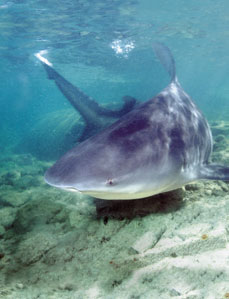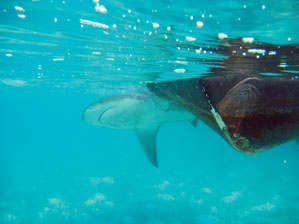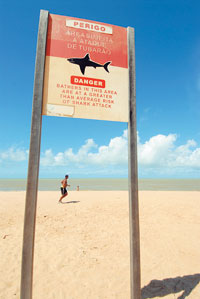
albert kok/wikimediaBull shark: associated with most of the shark attacks on the Brazilian coastalbert kok/wikimedia
Unlike the scenes shown in Jaws, Steven Spielberg’s film launched in 1975, the monstrous, sharp-toothed fish does not normally expose its fin out of the water to announce an attack. The shark swims by very quietly and remains entirely underwater. This is how one rainy afternoon in May 1999 a bull shark (Carcharhinus leucas) seized the leg of Pernambuco surfer Charles Barbosa Pires and pulled him to the bottom of the sea while shaking his body. Charles was trying to defend himself by punching the shark, when his friends, who had come out of the sea and called the firemen, started yelling at him to swim. “I heard that and started swimming. I swam until I was totally exhausted and then I fainted,” he says. When he woke up in the hospital, both arms were in bandages and his hands were missing.
Today, Charles, who is now 31 years old, is surfing again, after having overcome the fear of being attacked again and recovering from the physical and psychological aftereffects of the bites – at the moment, he is looking for financial aid to get two hand prostheses which cost approximately R$ 100 thousand. He is one of the 32 survivors of the 51 shark attacks registered in the period from 1992 to 2006 – which caused 19 deaths – on the coast of Recife, the capital city of the State of Pernambuco, the Brazilian state with the highest number of attacks of this kind. Globally, Brazil ranks as the seventh country – the United States is the first, where 836 such accidents were registered in the last 330 years, followed by Australia, where 329 attacks were registered in 300 years, according to the list prepared by the International Shark Attack File/ISAF of Florida’s Natural History Museum. Although there have been less attacks here in Brazil, there have been proportionally more deaths because the victims die from the shark bites. “In Brazil, the adult bull sharks are responsible for most of the attacks, and cause deeper and bigger injuries,” explains fishing engineer Fábio Hazin, a researcher at the Federal Rural University of Pernambuco/UFRPE.
In the last few years, Hazin and U.S. researchers have analyzed shark attacks on the coast of Pernambuco in search for explanations for these accidents. They have now come to some conclusions. On the Pernambuco seacoast, shark attacks on surfers or swimmers are associated with two factors: human-provoked changes in the environment and the stubbornness of people who insist on swimming near regions where sharks are usually found.
From the late 1970’s to the early 1980’s, the construction of the Porto de Suape port, approximately 40 kilometers south of Recife, required the destruction of a vast mangrove swamp. Substituting the mangrove swamp vegetation with concrete seems to have affected the population of fish and crustaceans that reproduce in the mangroves, interfering with the marine food chain.
Recently, Hazin, George Burgess, from ISAF, and Felipe Carvalho, from the University of Florida, observed that the disposal of organic material from garbage dumps and untreated domestic sewage and the use of agricultural fertilizers and pesticides, have been polluting the estuaries of the rivers where bull sharks reproduce, – apparently the bull shark has caused the most victims on the beaches of the Grande Recife metropolitan region; of the eight cases in which it was possible to identify the shark species on the basis of the shark bites, seven were bull shark bites. Such polluting substances affect the fish in the river estuaries and attract the more aggressive sharks, such as the bull shark and the tiger shark (Galeocerdo cuvier).
The Jaboatão River, one of the rivers where the sharks reproduce, is also one of the most polluted rivers in the city. The mouth of the river is located between Recife’s Boa Viagem and Paiva beaches. A comparison of a survey conducted in 1996 with another survey conducted last year by researchers from the Zootechnology and Fish and Aquaculture Department of the UFRPE suggests that the fish, crab, shrimp, and oyster populations living in the estuary of the Jaboatão River have declined by 90%. In 1996, there were 120 crabs per square meter. “Now, there are only 12 per square meter,” says Fernando Porto, the project coordinator.

lauren smith/www.sharkiologist.comAlso a victim: changes in river mouths affect the reproduction of bull sharkslauren smith/www.sharkiologist.com
In addition to organic waste, which comes from untreated domestic sewage, the Jaboatão is also contaminated by heavy metals, according to the study which evaluated 79 water quality parameters. To illustrate, the cadmium content – cadmium is a chemical element used in the battery and paint industries – was 2,800 times higher than the levels allowed by law. “This heavy metal is cancer-causing,” Porto states. Associated with pollution, the clearing of riparian forests on the riverbanks increases the quantity of sediments that flow into the waters; as a result, the waters are murky. Murkier waters increase the probability of shark attacks because sharks have trouble identifying their usual prey in such waters, according to a study published in March 2008 in the Bulletin of Marine Science. In the specialists’ opinion, sports practitioners – surfers and body-boarders – lead the victim statistics because they take higher risks when they’re in the sea and can also be more easily confused with prey. When seen under the water, the leg of a surfer sitting on a surfboard can be easily confused with a fish in a difficult spot, swimming confusingly near the surface.
In the beast’s way
But if there’s pollution everywhere, then why are shark attacks more frequent in Pernambuco? The answer might be found in the behavior of some shark species. The Pernambuco coast is part of the migration route of the tiger shark, one of 500 known shark species in the world.
During July this year, Hazin was able to track, with the help of a satellite, the journey of a young 1.5-meter long tiger shark. During this period, the shark traveled in a zigzag for more than 200 kilometers along the coast, from Recife, in Pernambuco, to the city of Natal, in the State of Rio Grande do Norte. “This behavior suggests that the animal follows the sea currents, which flow from the South to the North along the northeast coast of Brazil,” says Hazin. According to the researcher from UFRPE, the shark’s daily to-and-fro movement, close and farther away from the coast, was due to the variation in the level of the sea. “At low tide, the tiger shark swims away from the coast; at high tide, the shark swims closer,” says Hazin. The tiger shark also dives up to a depth of 212 meters during its journey.
Researchers already knew that the bull shark, a solitary fish which can reach a length of up to four meters and weigh half a ton, swims close to the coast because it swims to the estuaries in order to breed and raise the baby sharks. The constant presence of tiger sharks, which live in groups, still needed an explanation. “Now we know that this is a migratory behavior,” says Hazin, who still does not know the reason for the displacement. “We believe that this is a reproduction habit, because we monitored a young shark. This could be a seasonal migration,” says the researcher. Hazin, who is the director of the Department of Fishing and Aquaculture of UFRPE, states that it will be necessary to monitor other tiger sharks to establish the migration route of the species and the causes of the displacement.

MARCOS MICHAELSWarning on beaches: signs inform about the risk of accidentsMARCOS MICHAELS
Damage caused by fish
In an attempt to reduce the number of shark-caused attacks, the State Government of Pernambuco put up warning signs on the beaches, warning about the risk of attacks. In 2004, the state government created the State Committee for the Monitoring of Shark Incidents/ Cemit. In the last few years, the Cemit has already captured nine bull sharks and 31 tiger sharks with the objective of studying the behavior of this species. The monitoring program was interrupted for 15 months, from 2004 to January this year, because of a lack of funds. “Ten attacks occurred during this period, while only one attack was registered in the other 41 months,” says Hazin, who presides over the Cemit. Since 2007, the captured sharks have been taken far away from the coast. They are marked and equipped with satellite monitoring devices before they are set free. Hazin hopes to learn more about the habits of these species with this strategy.
Lately, the researchers from UFRPE have also recommended that shrimp fishing with fishing nets, which drags up crustaceans and fish from the bottom of the sea and damages the coral reefs, only be allowed five nautical miles off the coast – one nautical mile corresponds to 1.8 kilometers. The reason is because the fish that are captured and thrown back into the sea by the shrimp boats attract sharks, which increases the risk of attacks. Estimates are that one kilo of captured shrimp results in fifty kilos of fish, shellfish and crustaceans being thrown back into the sea, because they’re too small for consumption or are not commercially attractive. “Most of them are young fish, which have never reproduced and are already dying,” says fishing engineer Paulo Oliveira, from UFRPE. A pilot study conducted in Brasília Teimosa, in Recife’s South Side, indicates that nine fish species – all of them commercially attractive and one protected by law because it is an endangered species – are discarded by the shrimp boats. “These fish include flounders, moonfish, anchovies, sardines, manjubas and carapebas. These are edible fish, that could have been sold if they had grown more,” says Oliveira. The discarded fish also included the spotted grouper, which is on the list of endangered species. The Instituto Nacional do Meio Ambiente e dos Recursos Naturais Renováveis/Ibama, the Brazilian environmental authority, has banned the fishing of groupers for five years.
According to a technician from Ibama, the referred restriction would jeopardize fishermen because shrimp live in muddy waters next to the river estuaries. “You won’t find shrimp five miles off the coast. Banning fishing in that region means hundreds of families will have no means to survive,” says fishing engineer Euclides Dourado, from Ibama. Fishing with dragnets is banned up to one nautical mile off the coast of the states of Pernambuco and Alagoas, two nautical miles off the coast of the state of Sergipe and three nautical miles off the coast of the state of Bahia.
Scientific Article
HAZIN, F.H.V. et al. A shark attack outbreak off Recife, Pernambuco, Brazil: 1992-2006. Bulletin of Marine Science, v. 82, no. 2, March 2008.